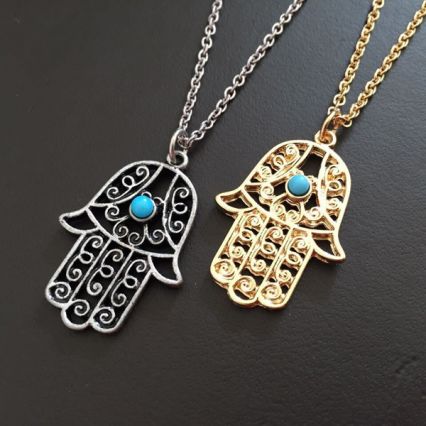LANGUAGES

LANGUAGES

The Hamsa, also known as the Humes hand, the Hand of Fatima and the Hand of Miriam is a popular symbol found throughout the Middle East and northern Africa, particularly within the Islamic and Jewish faiths.
The Hamsa
The Hamsa appears in two forms: stylized with two symmetrical thumbs and asymmetrical, with a clearly defined thumb and pinkie finger. Either form may be displayed with the fingers pointing up or down. The centre of the hand often contains further symbols, especially that of an eye, however different cultures may fill the hand with images relevant to them.
The first known use of the symbol can be traced to the civilization of Phoenicia that spread across the Mediterranean between 1550 – 330 BCE. The Phoenicians used an image of the hand to represent Tanit, patron goddess of their capital Carthage and controller of the lunar cycle.
With time, her hand became a protective amulet in its own right and was used to ward off the evil eye, one of the oldest manifestations of human fear. The symbol was adopted by the ancient Sephardic Jewish community of the Iberian Peninsular, who named it the Hand of Miriam after the sister of the biblical Moses and Aaron and associated it with the number five (hamesh in Hebrew) to represent the five books of the Torah.
It also symbolizes the fifth letter of the Hebrew alphabet, "Het", which represents one of God's holy names, and further reminds Jews to use their five senses when praising God.

PHOTO: TASNIM.AMINUS3.COM
Tradition
The hand, the eye, and the number five figure significantly in Arabic and Berber tradition and also relate to warding off the evil eye. Here, the Hamsa is called the Hand of Fatima after Fatima Zahra, daughter of the Prophet Muhammad. The five fingers of the hand are further associated with the Five Pillars of Islam. While Qu'ran law prohibits the wearing of charms and amulets, the Hamsa symbol is often depicted in and associated with Islamic cultures.
The Hamsa today is popular as a protective charm in both Middle Eastern and Western cultures, and can be found incorporated into jewelry, wall hangings, key chains and other decorative household elements. But more importantly, the Hamsa is in the process of transcending it's origins to become a symbol of peace in war-torn Middle East, and many Jews and Arabs wear the Hamsa to demonstrate the common ground shared by them and the common source from which their religions spring. No longer just a talisman, the Hamsa has instead become a symbol of hope and peace in the modern world.
RELATED ARTICLES
OTHER ARTICLES

LUCK & MONEY
Elephant figuresElephant is a symbol of strength, power, stability and wisdom. The lucky elephant charm is a deliberate bit of cultural exoticism found in America and Europe.

TRADITION
Amulets and TalismansAmulets and talismans vary considerably according to their time and place of origin. In many societies, religious objects serve as amulets. A religious amulet might be the figure of a certain god or simply some symbol representing the deity such as the cross for Christians or the "eye of Horus" for the ancient Egyptians.

HARMONY BALLS
Bola balls for expecting MamasThe Mexican Bola is designed to create a gentle soft chiming sound during mums movement and the baby is relaxed by these chimes up until the birth. Pregnant women wear the sound ball directly at stomach height.
OLDER ARTICLES
LATEST FORUM UPDATES
tatamata, Monday, 21.11.2016 / 9:01
NEW ARTICLES
POPULAR ARTICLES